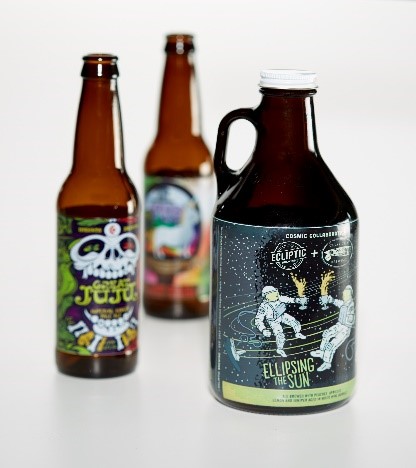- Equipment
- Inks & Supplies
- Services
- Applications
- Tagless
- Resources
- About Us
- Contact Us

UV inks are excellent for a wide variety of substrates for many reasons. First, the physical properties of the cured inks outperform various other types of ink on the market. These properties include but are not limited to better adhesion, chemical and abrasion resistance, and vibrant colors. UV inks also allow for a safer production environment free of additional chemicals. When UV inks are exposed to UV light rays, a photochemical reaction occurs which causes the UV ink to cure instantly at low energy levels. This eliminates drying time and increases overall workflow productivity, all while saving energy. UV inks are quickly becoming a popular alternative to traditional inks for these reasons.
The chemical composition of UV ink includes 4 main components which contribute to its exceptional physical properties: monomers, oligomers, pigments, and photo-initiators, as well as other additives. Some possible additives include adhesion promotors, pigment dispersing agents, and gloss promotors. Monomers are the building blocks of UV ink. They contribute to the physical softness/hardness of the ink after its cured, as well as help to control ink viscosity. The pigment particles give the ink its vibrant colors and should be finely milled to at least 200 nanometers in order to jet reliably and optimize print quality. The smaller and more precise the ink droplets are, the higher quality the image will be. Oligomers are made up of reactive resins and specially formulated adhesive components which allow the ink to be printed on a wide variety of substrates. Ultraviolet (UV) rays are used to instantly cure the ink through a photochemical reaction. The process wouldn’t be possible without photo initiators, which are molecules in the ink that absorb UV light as a form of energy to initiate the curing reaction.
Our diagram below demonstrates the UV curing process. The molecules of ink appear randomly dispersed at first, then get energized by UV light, causing strong bonds to form immediately, thus curing the ink.
At Inkcups, we provide only the highest quality UV inkjet inks available. All of our inks offer exceptional abrasion resistance and bright vibrant pigments. Depending on the substrate, the ink that will be right for your applications will vary. Read our ultimate guide to UV inkjet printing to learn all about digital printing including what exactly inkjet ink is and the most common types of inkjet inks used with UV printers.
Our S1 UV Inkjet ink is designed for all Inkcups’ digital printing machines. This ink adheres to a wide variety of rigid substrates including glass, plastic, and metal. S1 UV inkjet ink is cured instantly by UV LED light which means no drying time is required. The S1 Series ink offers bright, vibrant colors, excellent adhesion, and high abrasion resistance.
Available Colors: Cyan, Magenta, Yellow, Black, White, and Varnish
Compliance: Prop. 65 compliant
Applications: Stainless steel tumblers, machine panels, pens, chip clips, power banks, hard coolers, and more!
Additional Resources: All About Ink: Hard Ink
Our DL Series UV ink for glass is optimal for rigid glass products, yet also flexible enough to print on plastic and powder-coated materials. The DL Series can be paired with our primers and inkjet printing auxiliary machines for longer lasting adhesion and increased abrasion resistance.
Available Colors: Cyan, light cyan, Magenta, light magenta, Yellow, Black, White and Varnish
Compliance: FDA 21CFR compliant
Applications: Glassware, candle holders, mason jars, pint glasses, growlers, glass coasters, ash trays, and more!
If you are a searching for a durable, long lasting ink for flexible products, look no further. Stretch, bend, twist, squeeze or fold, XFlexx will not crack or distort. XFlexx is a high durability ink available for all of Inkcups’ UV inkjet printers.
Available Colors: Cyan, Magenta, Yellow, Black, White and Varnish
Compliance: Chapter 70.240 RCW (safe for children’s products due to absence of lead, cadmium, and phthalates)
Applications: Stress balls, flexible coolers, lunch boxes, and more!
The Candymark edible inks are used to print bakery and confectionery products with full-color images. Edible inks are compatible with all of Inkcups’ flatbed inkjet printers. Add our Candymark ink to any of these printers and turn a standard inkjet printer into an edible ink printer. Print directly onto your confectionery creation. The edible inks have no flavor and will not alter the taste of any item they are printed on.
Available Colors: Cyan, Magenta, Yellow, and Black
Compliance: FDA approved
Applications: Candies, cookies, cakes, and almost any other edible substrates!
Additional Resources: All About Ink Series: Edible Ink
For Tritan™ manufacturers who would like to speed up production and ensure adhesion, the T2 Series digital ink provides exceptional adhesion without the need for an additional primers or pre-treatment. The T2 ink has been tested in the field for over two years with exceptional results.
Available Colors: Cyan, Magenta, Yellow, Black, White and Varnish
Applications: Barware, food storage containers, serving dishes, blenders, water bottles, and any other product made from Tritan™ plastic!
For drinkware manufacturers or decorators who are dissatisfied with the flexibility of other digital inks, the BB Series digital ink provides a durable ink for flexible surfaces that can pass the ice bucket and extreme squeeze tests.
Available Colors: Cyan, Magenta, Yellow, Black, White and Varnish
Applications: Bike bottles, reusable bags, industrial tubing, sports balls, tactical gear, leather goods, and more!
Add Your Comment